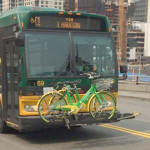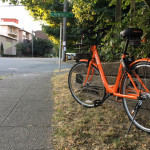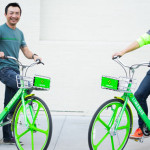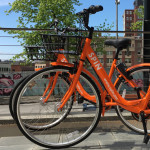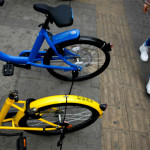Three reasons why a bike share will work in Seattle
Jun 22, 2017, 7:30 AM
Yes, there are hills. Yes, it rains here a lot. And yes, Seattle’s own bike-share program Pronto went flat. But a bike share will still work in Seattle despite the usual arguments.
“Seattle is the third largest market in the country that doesn’t have a bike sharing program of any sort,” said Gabriel Scheer, director of strategic partnerships for Limebike, one of 10 bike share companies currently gearing up to operate in Seattle.
“After Pronto failed, this became one of the three hottest cities in terms of the size of the program where you could launch and not be competing against dock-based systems.”
RELATED: Why Spin bike share thinks it will succeed in Seattle
Seattle is currently setting up pilot bike-share permits for the 10 companies to test their operations in town. It is unknown exactly when the pilots will go active, but it is speculated that the bikes will hit the street sometime this summer.
The sharing industry is not new to Scheer. He worked at Zipcar, the car sharing company already popular in Seattle. Members find a car using their smartphone which unlocks the car. They go for a drive, park it, and leave it for the next driver. It’s a system that bike share companies want to use in Seattle.
Bike share tech
The term “smart bike” gets thrown around a lot when discussing the type of bike share coming to Seattle. With Pronto, you had to ride a bike from dock-to-dock. LimeBike and the other companies are ditching the docks, however. The bikes will be parked in the furniture or landscaping zones of sidewalks. The rear wheel is locked until a rider uses their smartphone to unlock it for a trip. It’s generally $1 to ride — much cheaper than Pronto.
This system will accomplish two things: it will make the bikes easier to ride for individual needs, and it will allow the bike shares to expand their reach.
I never rode on a Pronto bike. There were never any available for me to ride in my North Seattle neighborhood. Yet, there were plenty available for folks looking for a thrill ride down Capitol Hill.
“Pronto had around 500 bikes in downtown, Capitol Hill, U-District, and a little in Eastlake, but otherwise they weren’t there,” Scheer said. “If I wanted to grab a bike and take it to somewhere … there weren’t enough to count on having a bike and a station at the end of my trip.”
“Pronto, you can point to a lot of different things (that killed it), one of them was a lack of network,” he said. “… If I can’t rely on this option to be there, I am more likely to choose the one that is there, which is my car.”
So hopefully, a successful bike share in Seattle will be as accessible to someone in Rainer Valley or Roosevelt as Pronto was on Capitol Hill. The Spin bike share has promoted it aims to equally cover Seattle.
Expanding transit
A common mistake that the anti-bike share crowd often makes is looking at the city through their windshield. Not everyone has their transportation needs. But in the end, a bike share — or a bus, a light rail line, etc. — won’t replace a car.
“I don’t think the car goes away for most people because we have bike sharing,” Scheer said. “That’s not what I’m suggesting. What I am suggesting is you need lots of options and you need them to be omnipresent to really count on those as an alternative.”
There is a proven track record of commuters seeking alternatives to sluggish traffic. Downtown Seattle added 45,000 new jobs between 2010 and 2016, yet only 2,255 cars were added during that same time. Buses, light rail, bikes and walking absorbed of the rest.
King County Metro announced a record year of ridership in February totaling around 150 million rides. In fact, with a 5 percent bump between 2015-16, the Seattle region led the nation in transit ridership growth.
Sound Transit’s ridership has also increased. Last March showed a 54.4 percent increase in weekday light rail trips, compared to March 2016. Transit agencies also report that neighborhoods just a short distance from light rail stations are experiencing a jump in bus rides to the stations.
That’s where bikes come into play. They bridge the gap between home and the bus stop, cafe or other.
Desire to ride
One of the more common arguments against biking in Seattle is that only a small percentage of commuters are cyclists. Depending on who you ask, statistics range from 3 percent of 250,000 downtown workers, to 3.4 percent of all 350,000 Seattle workers. It could be said that is a small percentage. But if you break that down, it means that between 7,500-11,900 commuters use a bike in Seattle. That’s a lot of people putting two wheels on the road despite hills and rain.
That’s about the entire population many of Washington’s small towns –like Kelso, Ferndale or Port Orchard — moving through Seattle. Imagine everyone in Woodinville hopping in a car and swarming Seattle’s streets. Then try and say that it’s a small percentage of commuters.
The Cascade Bicycle Club alone has more than 17,000 members from throughout the region. They won’t likely be using the bike share systems, however. They have their own bikes. But that does indicate plenty of support.
The number of companies speeding into town is another testament to the desire for a Seattle bike share. Many of these businesses are startups, leveraging millions of dollars. It indicates a confidence in the business model and the market. At the very least, it shows that there is an incentive to make it successful.


